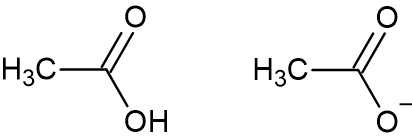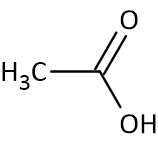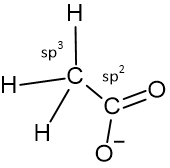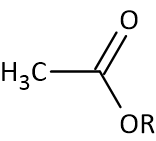




What is Acetate?
Most of us are familiar with vinegar, it is a common kitchen ingredient having a sour taste. Vinegar is an aqueous solution of acetic acid (IUPAC name: ethanoic acid), with the chemical formula CH3COOH. When the acid loses a proton, the anion of the acetic acid is termed an ‘acetate anion’. When the acetate anion combines with a cation, the compound is called an ‘acetate’. The simplest acetate is hydrogen acetate, which is another name for acetic acid.

a) Acetic Acid b) Acetate Anion
Acetate is the conjugate base of acetic acid. The acetate ion is commonly abbreviated as AcO- or -OAc. Acetic acid is a weak acid which dissociates in water to release a proton and an acetate ion at a pH of 5.5 or above. Acetate chemical formula is CH3COO-
CH3COOH + H2O ⇌ CH3COO- + H3O+
A very well-known reaction of vinegar (acetic acid) and baking soda (sodium bicarbonate) produces an acetate ester (sodium acetate). This mixture is often used for cleaning purposes.
CH3COOH + NaHCO3 → CH3COONa + CO2 + H2O
In human biology, acetate is one of the most common building blocks for biosynthesis, such as fatty acid synthesis. It is a common anion found in Biology.
Table: Properties of Acetate Ion
Acetate Structure
Acetate contains one methyl group(-CH3) which is bonded with a carbonyl carbon. The carbonyl group is connected to another oxygen with a negative charge along with the methyl group.

Acetate Anion
The methyl carbon is sp3 hybridised and has a tetrahedral geometry; the connected carbonyl carbon is sp2 hybridised that is doubly bonded to neutral oxygen and singly bonded to a negatively charged oxygen. However, both the oxygen is equivalent due to the delocalization of electrons through resonance.

Hybridisation Sates of Acetate Anion
The negative charge over one oxygen shifts to form a double bond with the carbonyl carbon, while the existing double bond dissolves and the electron cloud is pushed over the other oxygen atom with the accumulation of negative charge. This delocalization results in equal distribution of the negative charge on both the oxygen atoms of the acetate anion.

Delocalisation of Negative Charge by Resonance
Acetate Esters
In Organic Chemistry, acetate esters are the esters of acetic acid, where the acetate anion combines with an organyl group (R). Acetate esters are generally represented as CH3COOR. These esters are generally fragrant liquids with low toxicity and are lipophilic and, sometimes, volatile.

Acetate Ester
Acetate Biochemistry
Acetate is broken down in nature by fermentation carried out by methanogenic archaea. The microbe catalyses the dismutation of acetic acid, which is a disproportion reaction; a single electron from carbonyl (e- donor) of the carboxylic acid is transferred to the methyl group (e- acceptor), releasing methane and carbon dioxide.
CH3COO- + H+ → CH4 + CO2
Acetate is produced by gut bacteria by fermentation. It is also derived from diet and generated from various tissues like the intestine and liver. Deacylation reaction produces acetate in all cells. The acetates, in order to be utilised, are converted into acetyl coenzyme A (acetyl-CoA).
Acetyl-coenzyme A is converted into acetate while producing ATP (the energy currency) during substrate-level phosphorylation in E.Coli.
Acetyl-CoA + phosphate → acetyl-phosphate + CoA
Acetyl-phosphate + ADP → acetate + ATP
Acetyl CoA is involved in lipid, protein and carbohydrate metabolism. In the citric acid cycle, it delivers the acetyl group that leads to the production of energy.
Uses of Acetate
Acetate is used largely in the production of vinyl acetate, a precursor to polyvinyl alcohol used as a component of paints.
‘Acetate’ is often used as a substituent for cellulose acetate, which is produced using acetic acid. Cellulose acetate is used in the production of fibres.
Variety of industrial solvents are acetates, such as methyl acetate, ethyl acetate, isopropyl acetate and butyl acetate (used as a fragrance in food products).
Interesting Facts
Acetates have been found to have immunomodulatory properties, affecting innate immune response to pathogenic bacteria.
Most of the acetic acid produced annually (about 5 billion kilograms) is consumed in the production of acetates.
Key Features
‘Acetate’ refers to the compound containing the acetate anion and another cation.
Chemical formula of acetate anion is C2H3O2- or CH3COO-.
Acetic acid is the simplest acetate. Hydrogen cation and the acetate anion combine to form hydrogen acetate (acetic acid: CH3COOH)
Acetate is utilised in the form of acetyl CoA in biological systems. It is used in various metabolism to yield energy, and in biosynthesis, it serves as a common building block.
FAQs on Acetate
1. How Does an Acetate Produce?
The acetate fiber develops by using acetic anhydride to react with the wood pulp of high purity. The acetate flakes formed by this chemical reaction are dissolved in a solvent, filtered, and then modified to obtain a spinning stock solution.
The acetate anion belongs to the carboxylate family, and it is considered a conjugate base of acetic acid. The acetic acid was converted to acetate at a pH value of above 5.5. Acetate is a common anion in Biology, where organisms utilize it in the form of acetyl coenzyme A. It is also proposed that acetate produced by oxidizing ethanol is a major factor for causing hangovers.
2. Give Some Advantages and Disadvantages of Acetate?
Acetate is among the most flexible fabrics, and it can resist wrinkling.
Let us look at some of the advantages and disadvantages of it below.
Advantages - It has a silky appearance and a luxurious feel to it.
Disadvantages - The dyes can bleed or fade, are prone to heat, and are relatively poor fibres. Acetate can be used as a hand wash and for clothes with warm water, and as a light-duty detergent.
3. Is Acetate an Acid or a Base?
The sodium acetate is a basic salt, where the acetate ion will deprotonate water, thereby increasing the pH value of the solution. The acid salts are a converse of the basic salts, and they are produced in the neutralization reaction between the strong acid and a weak base. Then, the conjugate acid of a weak-base makes the salt acidic.
4. How does acetate differ from acetic acid?
The most important distinction between acetate and acetic acid is that: acetate is a negatively charged compound, whereas acetic acid is a neutral compound. It can be distinguished from their molecular formula, CH3COO- (acetate; net negative charge on the molecule) while CH3COOH (acetic acid; no net charge on the molecule)
5. What is the nature of acetate?
Acetate anion is the conjugate base of acetic acid, so it is basic in nature.
6. What is an acetate buffer?
Acetate buffer commonly used is sodium acetate buffer. It is made of a mixture of acetic acid and sodium acetate. The pH range of the buffer is 3.5 to 5.5.











